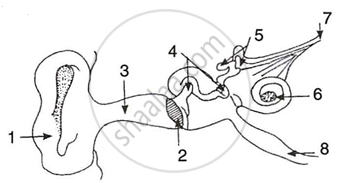Advertisements
Advertisements
प्रश्न
The following diagram refers to the ear of a mammal.

(i) Label the parts 1 to 10 to which the guidelines point.
(ii) Which structure:
(a) converts sound waves into mechanical vibrations?
(b) Converts vibrations into nerve impulses?
(c) Responds to change in position?
(d) Transmits impulses to the brain?
(e) Equalizes atmospheric pressure and pressure in the ear.
उत्तर
(i)
1. Cochlea.
2. Auditory nerve.
3. Semi-circular canals.
4. Ear ossicles.
5. Auditory meatus.
6. Pinna.
7. Er drum.
8. Fenestra rotunda.
9. Eustachian tube.
10. Fenestra ovalis.
(ii)
(a) Ear drum or tympanum.
(b) An organ of Corti.
(c) Semi-circular canals.
(d) Auditory nerve.
(e) Eustachian tube.
APPEARS IN
संबंधित प्रश्न
Write short notes on the following: Cochlea
Answer the following:
Which part of the ear determines the pitch of a sound?
Time taken by an object to complete one oscillation is called ___________.
State the exact location of the Organ of Corti
Where is the Semicircular canals located? Briefly mention its function.
With reference to the human ear, answer the question that follow:
Give the technical term for the structure found in the inner ear.
Given below is the diagram of the human ear. Study the diagram and then answer the questions that follow:

(i) What role does the eardrum play in hearing?
(ii) What common term is given to the parts labeled A, B, and E?
(iii) Would there be any difference if these three parts mentioned in (ii) above were replaced by one by one? Why?
(iv) Give the biological term for the parts labeled C and D.
(v) Name the fluid which fills the parts mentioned in (iv) above.
(vi) State the functions of the ear.
Mention, if the following statement is True or False
The part of ear associated with balance is the cochlea.
Mention, if the following statement is True or False
Deafness is caused due to the rupturing of the pinna.
Name the three ossicles of the middle ear.
Long answer question
Draw the neat labelled diagram of the human ear.
The hearing range of the human ear is ______.
The eardrum is known as ______.
Given below is a diagrammatic representation of a part of the human ear.
- Name the parts numbered 1-6.
- Which parts of the ear shown here are complete.
 |
Note the relationship between the first two words and suggest the suitable word/words for the fourth place.
Ear pinna : Auricle :: Inner ear : ______.
Define the following term:
Ear ossicles
With reference to human ear answer the question that follow:
Name the part of the ear associated with the amplification of vibrations.
- Draw a neat and well labelled diagram of the membranous labyrinth found in the inner ear.
- Based on the diagram drawn above in (i), give a suitable term for each of the following descriptions:
- The structure responsible for hearing.
- The sensory cells that help in hearing.
- The membrane-covered opening that connects the middle ear to inner ear.
- The nerves that carry impulses from the ear to the brain.
- The tube which equalises the air pressure on either side of the ear drum.
Name the part of the inner ear that is responsible for static balance in human beings.
The figure given below shows the principal parts of a human ear. Study the diagram and answer the following questions.
 |
- Label the parts 1 to 8.
- State the role of parts 6, 7 and 8.
- Why is it harmful to use a sharp object to remove ear wax? Mention the number and name of the part involved.
